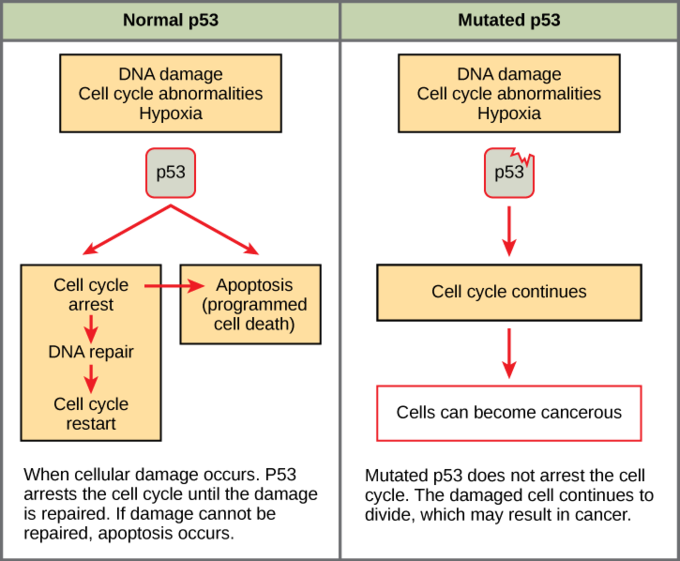10.4B: Tumor Suppressor Genes
- Page ID
- 13244
- Describe the role played by tumor suppressor genes in the cell cycle
Like proto- oncogenes, many of the negative cell cycle regulatory proteins were discovered in cells that had become cancerous. Tumor suppressor genes are segments of DNA that code for negative regulator proteins: the type of regulators that, when activated, can prevent the cell from undergoing uncontrolled division. The collective function of the best-understood tumor suppressor gene proteins, Rb, p53, and p21, is to put up a roadblock to cell cycle progression until certain events are completed. A cell that carries a mutated form of a negative regulator might not be able to halt the cell cycle if there is a problem. Tumor suppressors are similar to brakes in a vehicle: malfunctioning brakes can contribute to a car crash.
Mutated p53 genes have been identified in more than one-half of all human tumor cells. This discovery is not surprising in light of the multiple roles that the p53 protein plays at the G1 checkpoint. A cell with a faulty p53 may fail to detect errors present in the genomic DNA. Even if a partially-functional p53 does identify the mutations, it may no longer be able to signal the necessary DNA repair enzymes. Either way, damaged DNA will remain uncorrected. At this point, a functional p53 will deem the cell unsalvageable and trigger programmed cell death (apoptosis). The damaged version of p53 found in cancer cells, however, cannot trigger apoptosis.

The loss of p53 function has other repercussions for the cell cycle. Mutated p53 might lose its ability to trigger p21 production. Without adequate levels of p21, there is no effective block on Cdk activation. Essentially, without a fully functional p53, the G1 checkpoint is severely compromised and the cell proceeds directly from G1 to S regardless of internal and external conditions. At the completion of this shortened cell cycle, two daughter cells are produced that have inherited the mutated p53 gene. Given the non-optimal conditions under which the parent cell reproduced, it is likely that the daughter cells will have acquired other mutations in addition to the faulty tumor suppressor gene. Cells such as these daughter cells quickly accumulate both oncogenes and non-functional tumor suppressor genes. Again, the result is tumor growth.
Key Points
- Tumor suppressor genes are segments of DNA that code for negative regulator proteins, which keep the cell from undergoing uncontrolled division.
- Mutated p53 genes are believed to be responsible for causing tumor growth because they turn off the regulatory mechanisms that keep cells from dividing out of control.
- Sometimes cells with negative regulators can halt their transmission by inducing pre-programmed cell death called apoptosis.
- Without a fully functional p53, the G1 checkpoint of interphase is severely compromised and the cell proceeds directly from G1 to S; this creates two daughter cells that have inherited the mutated p53 gene.
Key Terms
- apoptosis: a process of programmed cell death
Contributions and Attributions
- OpenStax College, Biology. October 16, 2013. Provided by: OpenStax CNX. Located at: http://cnx.org/content/m44463/latest...ol11448/latest. License: CC BY: Attribution
- oncogene. Provided by: Wiktionary. Located at: en.wiktionary.org/wiki/oncogene. License: CC BY-SA: Attribution-ShareAlike
- proto-oncogene. Provided by: Wiktionary. Located at: en.wiktionary.org/wiki/proto-oncogene. License: CC BY-SA: Attribution-ShareAlike
- mutation. Provided by: Wiktionary. Located at: en.wiktionary.org/wiki/mutation. License: CC BY-SA: Attribution-ShareAlike
- Possible Pathways that turn Proto-oncogenes into Oncogenes. Provided by: Wikimedia. Located at: commons.wikimedia.org/wiki/Fi..._Oncogenes.jpg. License: CC BY-SA: Attribution-ShareAlike
- OpenStax College, Biology. October 16, 2013. Provided by: OpenStax CNX. Located at: http://cnx.org/content/m44463/latest...ol11448/latest. License: CC BY: Attribution
- apoptosis. Provided by: Wiktionary. Located at: en.wiktionary.org/wiki/apoptosis. License: CC BY-SA: Attribution-ShareAlike
- Possible Pathways that turn Proto-oncogenes into Oncogenes. Provided by: Wikimedia. Located at: commons.wikimedia.org/wiki/Fi..._Oncogenes.jpg. License: CC BY-SA: Attribution-ShareAlike
- OpenStax College, Cancer and the Cell Cycle. October 16, 2013. Provided by: OpenStax CNX. Located at: http://cnx.org/content/m44463/latest...e_10_04_01.png. License: CC BY: Attribution


